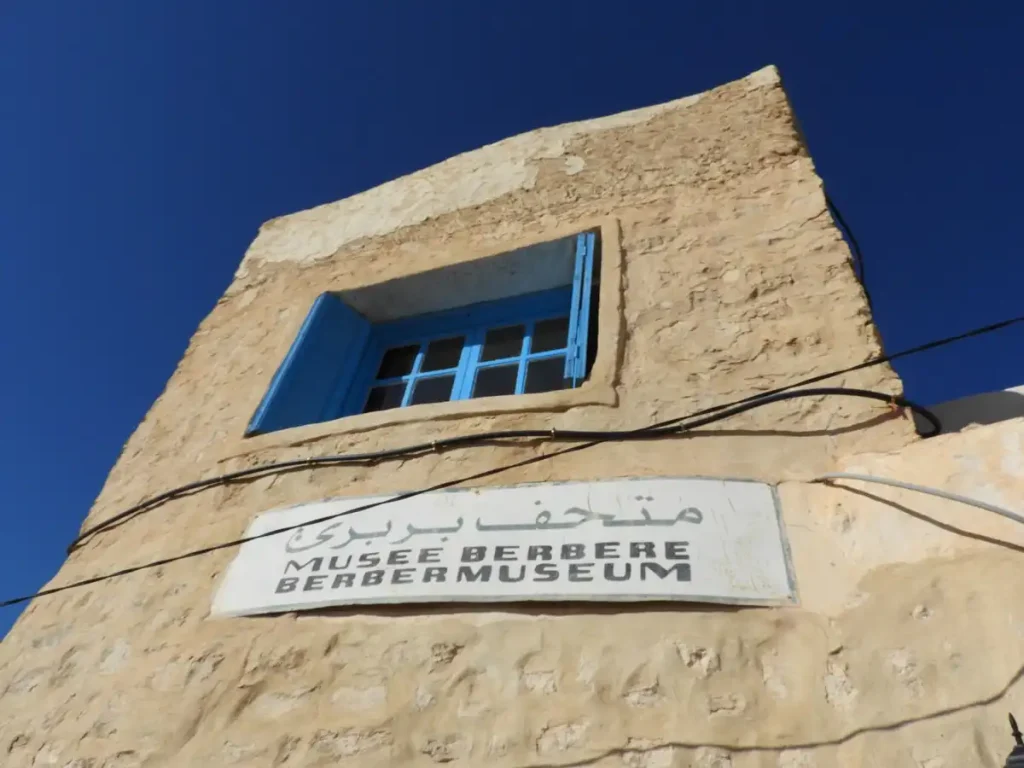The museum of Tamazret
The Berber Museum of Tamazret, hoisted to the highest point of the village, in the south-east of Tunisia, about ten km from Matmata and about forty km from Gabès, the Berber Museum is a must-visit. Created in 1999, it aims to protect and promote the region’s authentic Amazigh crafts and heritage. There are exposed: the architecture of the village and the organization of the habitat, the history of the religions, the traditions and social organization of the Amazigh, the weavings, embroideries and tattoos. The famous bakhnoug is reborn there from its ashes, Amazigh slippers and boots embroidered by hand according to traditional methods are made there by the director of the Museum himself Mr. Mongi Bouras, traditional woolen shawls woven and embroidered by hand, colored with natural pigments. The Director’s wife creates necklaces out of skhab (dried scented paste beads). These marvels are exhibited and for sale there. After the visit, it is strongly recommended to savor the typical dishes of the region at the Museum’s table d’hôtes (Berber krabbiz).
Located on a small road linking Matmata and Tamezret, this museum is a real journey into Amazigh and Berber history.
Through the various exhibits and thanks to the fascinating anecdotes and stories told by Mongi, the master of the place, visitors immerse themselves in the history of this region of the country which alone represents a piece of Tunisia.
In the village of “Tamezret”, a house which presents a typical horizontal semi-troglodyte architecture, is transformed into a museum, at the same time the house has kept its original morphology and its interior layout as it is designed by the inhabitant , adding some handicrafts for sale.
Moreover, changing the nature of a domestic house to make it a museum raises a main question, how should it be designed and exhibited in a museum context?
The constituent elements of the house are preserved, the house had become a prototype to be preserved as a whole, it reflects the technical, aesthetic and conceptual know-how of an architectural type adapted to natural and climatic conditions, integrating religious and moral references in its spatial organization, this complex construction which presents caves dug in the mountain and built constructions, implements architectural methods and techniques developed at length over millennia.
The patrimonialization of the house museum aims to reveal the content of an architectural form and a distinctive historical heritage where the know-how of several civilizations whose culture, religion and ethnicity are different, the museology of “home -soi” plays the role of cultural mediation to safeguard the heritage and form this place into a space to be discovered.
The relationship between heritage-making and cultural mediation is distinct from the process that is established between heritage as a representative of a culture and the public, this heritage highlights the particular, specific and unique features of a culture, and the representations of a community.
The patrimonialization following a cultural mediation is opposed to the destruction or the disappearance of the identity, thus the heritage is a historical witness it protects and illustrates the particularities of a culture, in this perspective the cultural mediation must play the role of transmission, communication or appropriation of knowledge, this role can be perfected in the museum space.
Museums are generally art, history, technology and science museums, several museums have spatial sessions, others temporal or thematic, “museums are also part of time and space and reflect the values and currents of the societies in which they participate, they evolve and their responses can only be temporary in the sense that they are condemned to perpetual questioning and questioning of their operational mode, in particular of mediation and enhancement”, the house museum tells the story of the lived space, projects the aspirations of its occupant and illustrates its culture.
In the house, outdated objects have undergone a transformation of use, the object has become an illustration of a reality that testifies to a practice, a technical mastery, a style and an era, these objects of everyday life have in fact become mediators between two realities, the past and the present, they are a sign object, a witness object and a heritage object, but objects never mediate without a discourse, a story or an interpretation that allows them to be classified in a context that gives it meaning.
The “home” has become an object carrying meanings and interpretations that represent the cultural, ethnic and religious identity of its manifestor.
We explain the different values of “home”, through cultural mediation, which is part of a social project, it designates animation and communication. Mongi Bourasse, owner of the house, has converted his home into a museum house, himself plays the role of a cultural mediator, to facilitate communication between objects and the public, his cultural mediation takes the form of educational mediation, he uses various means to make exhibits accessible.
The “home” has become a heritage and museum project that is transmitted not only from one generation to another but rather from one culture to another, the choice of a heritage approach to exhibit the “home” could be interpreted in two ways, as museology of a lived space or as a political and financial choice, it all depends on the social and cultural context in which the house museum is located.
The museology of the space of “home” of the semi-troglodyte house of “Tamezret”, is defined as a process of creation and restoration of the Berber culture, which evokes that this process deplores that the political and the social occupy the first rank in the aims of the establishment of this space.
The house museum is part of an agglomeration of semi-troglodyte dwellings, is defined as a place of cultural mediation, a place of symbolic representation which aims to redefine Berber culture, but the values of “The home” are transformed from privacy to the exhibition, from family value to heritage value, from a private space to a place of collective memory.
The Berber Museum of Tamazret in pictures

